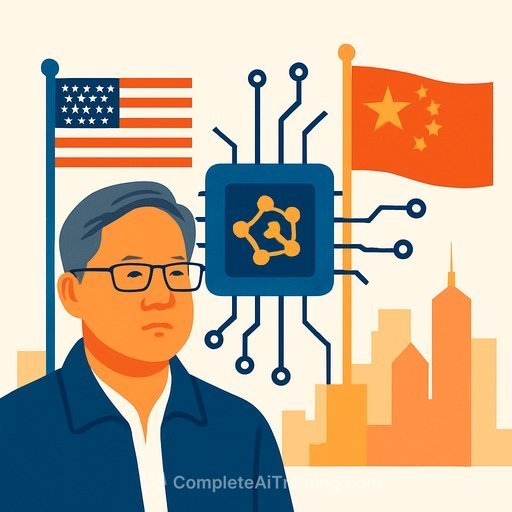China's AI Chips: What Investors Should Price In Over the Next 3-5 Years
The US has set the pace in advanced chips for decades. China is pushing to change that with heavy spending in AI, robotics, and the chips that run them. Nvidia's chief says China is "nanoseconds behind." The real question for capital markets: how fast can Beijing cut its reliance on imported high-end parts?
Why this matters for capital markets
- Revenue concentration risk: Nvidia's China exposure faces policy and competition pressure.
- Gross margin risk: Local alternatives can compress pricing for mid-tier accelerators.
- Capex cycles: Cloud and internet platforms in China may reallocate budgets to domestic chips.
- Policy premium: Export controls and probes add headline risk and valuation volatility.
- Energy economics: Chips claiming lower energy use change TCO math for data centers.
After DeepSeek: the confidence shock
DeepSeek's 2024 launch rivaled ChatGPT and reportedly trained with far fewer high-end chips. The event briefly hit Nvidia's market value and signaled that China can ship credible AI at lower cost. That momentum carried into 2025 with big names moving in.
Where China is catching up
Alibaba claims a new chip can match Nvidia's H20 while using less energy. H20 is a scaled-down processor built for China under US export rules. Huawei announced its most capable chips to date and a three-year plan to challenge Nvidia, while opening designs and software to attract local developers.
MetaX won deals with state-owned China Unicom. Cambricon's shares more than doubled in three months on hopes of state-backed demand. Tencent is also adopting more Chinese chips, aligning with domestic substitution goals.
Where China still lags
Experts warn that headline claims lack consistent public benchmarks. Testers report Chinese chips performing similarly to US rivals in predictive AI, but lagging in complex analytics. Ease-of-use and software maturity also trail Nvidia.
Supply chains are not yet as developed as in the US, South Korea, and Taiwan. Access to top-tier US parts remains limited under export rules, constraining training of the most complex models.
Policy dynamics to price in
Beijing's push doubles as leverage in tariff talks. Announcements project strength while still signaling demand for select US tech. Washington's export rules continue to curb China's access to advanced accelerators, a direct hit to the deepest dependency. For context on current rules, see the US Bureau of Industry and Security's guidance on advanced computing and semiconductor items (U.S. export controls on advanced computing).
How Nvidia is responding
Nvidia acknowledges the competition and says customers will pick the best stack for mainstream apps and open-source models. The firm's moat still leans on performance, software maturity, and developer loyalty. But local rivals are pressing where they can win: price, energy use, and domestic availability.
Three scenarios to underwrite (12-36 months)
- Base case: China lifts share in inference and mid-tier training with domestic chips; Nvidia holds the high end. Pricing pressure increases in China-focused SKUs. Global growth offsets some China softness.
- Bull case (for China incumbents): Transparent benchmarks validate parity in select workloads. Software improves, and state procurement accelerates. Domestic share gains broaden across cloud and telecom.
- Bear case (for China incumbents): Tighter export rules, slower software progress, and integration hurdles. Enterprises stick with proven US stacks for critical work. Substitution slows.
KPIs and catalysts to monitor
- Public, third-party benchmarks for Chinese accelerators across training and complex analytics.
- Software maturity: compilers, frameworks, and developer tooling; ease-of-migration from Nvidia stacks.
- Energy-performance metrics and real-world TCO in data centers.
- Large production orders from top Chinese cloud, telecom, and internet platforms.
- Policy headlines: new export rules, antitrust probes, or procurement mandates.
- Supply chain build-out: packaging capacity, memory availability, and lead times.
Portfolio implications
- Nvidia and US peers: Expect China mix volatility and price pressure on constrained SKUs. High-end demand outside China supports the growth arc; watch margin discipline.
- Chinese chip designers: Upside tied to credible benchmarks, software adoption, and state-backed orders. Execution and integration risk remain high.
- Chinese cloud/internet carriers: Potential capex shift to domestic parts could improve procurement certainty and unit economics if performance holds.
- Upstream suppliers (memory, packaging): Benefit from both camps as total AI capex expands; track pricing and capacity additions.
Action steps for finance teams
- Stress test models for multiple pricing paths in China-exposed AI hardware.
- Separate training vs. inference exposure; domestic gains likely start in inference-heavy workloads.
- Demand third-party benchmarks before underwriting material share gains for new entrants.
- Build vendor-risk playbooks that factor export controls and procurement mandates.
- Upskill teams on AI's P&L impact and tooling; a curated starting point: AI tools for finance.
What to watch next
- Rollouts of Alibaba and Huawei chips into production at major clouds.
- Cambricon's customer wins beyond pilot phases and any international expansion signals.
- Updates from DeepSeek on model quality and training footprints.
- Any step-up in US export restrictions or shifts in Chinese procurement policy.
The gap is narrowing, especially on cost and energy use for targeted workloads. The high end is still US-led, but five years can be a long time in semis. Price the spread, track the software, and let verified performance-not headlines-drive your allocations.
Your membership also unlocks:






